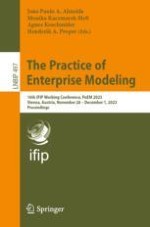2024 | OriginalPaper | Chapter
Using the Business Motivation Model as an Organising Principle to Clarify Public Policy
Authors : Helena Zhemchugova, Friederike Stock, Lutho Madala
Published in: The Practice of Enterprise Modeling
Publisher: Springer Nature Switzerland
Activate our intelligent search to find suitable subject content or patents.
Select sections of text to find matching patents with Artificial Intelligence. powered by
Select sections of text to find additional relevant content using AI-assisted search. powered by
